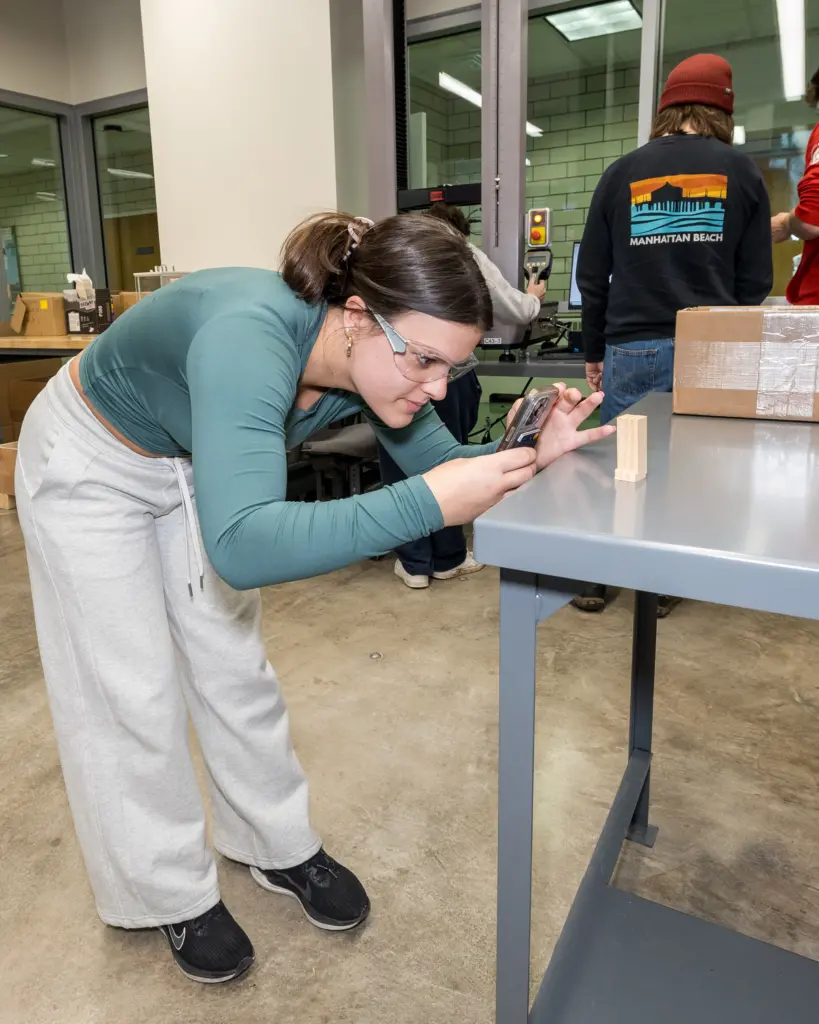Renovations to the mechanics of materials testing laboratory in Engineering Hall will expand student understanding of materials deformation physics and demonstrate how materials choices affect every engineering discipline.
Mechanical Engineering Professor Curt Bronkhorst chaired the committee overseeing the project, which has been in the works for nearly four years. The renovations have modernized the lab space, which was last updated in 1996. Work on the lab, located in 1313 Engineering Hall, was largely completed in time for the spring 2024 semester, with a few finishing touches to conclude over the following weeks.
“The lab has been redesigned to be able to accommodate two classes, when we could only hold one in it before,” Bronkhorst says. “The ability for faculty to use this for a classroom setting is going to be substantial now.”
 A student takes a picture of a piece of wood damaged during a compression test in the mechanics of materials testing lab. The lab exposes students from across the College of Engineering to the ways in which materials impacts their fields of study. Credit: Joel Hallberg.
A student takes a picture of a piece of wood damaged during a compression test in the mechanics of materials testing lab. The lab exposes students from across the College of Engineering to the ways in which materials impacts their fields of study. Credit: Joel Hallberg.
The new renovations have added lots of new tools: The College of Engineering has purchased $1.5 million in new equipment to bolster the types of tests students and faculty can perform in the space. Bronkhorst says the equipment will enable testing materials for performance at different temperatures, types of load conditions (static, cyclic, etc.), load capability, and more.
While the mechanics of materials testing laboratory has long hosted EMA/ME 307: Mechanics of Materials, which is required for many undergraduate engineering students, Bronkhorst says it has tremendous potential for use as a space for many additional classes. The planning committee identified a list of roughly 50 classes across the College of Engineering that could use the space, ranging from advanced pavement design to biomechanics to radiation damage in metals.
The renovation underscores the importance the College of Engineering places on providing multidisciplinary educational and research opportunities for its students and faculty. To that end, the equipment upgrades not only enable a wider variety of classes, but also can enhance the types of research experiments that can be performed in the laboratory space.
Ultimately, that should give future UW-Madison engineers hands-on experience with the various ways in which materials shape many aspects of the different areas of engineering.
“Having a serious classroom area for mechanics of materials will demonstrate to our students how important materials are to all of the fields of engineering in the college,” Bronkhorst says. “For example, when you turn on a computer, the parts inside heat up and they expand. Electronics failures can, in part, be due to material failures. Materials impact so much of what we do as engineers and even in just our everyday lives, so exposing our students to a broad range of testing capabilities will help them to understand the richness of this field.”
Featured image caption: A student group watches as a wood block deforms under pressure during a lab session in the newly renovated mechanics of materials testing laboratory in Engineering Hall. Credit: Joel Hallberg.